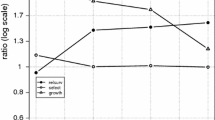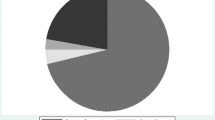Abstract
An unsolved problem in modern labor economics is the positive relation between the size of the firm in which a worker is employed and his wage. One line of research that has been developed quite recently in this field is the application of endogenous switching regression models. In this paper we utilize such a model to investigate firm-size wage differentials in the Netherlands. The principal findings are that larger firms pay higher returns on schooling whereas smaller firms tend to reward IQ. Combined with the finding that high IQ-workers are sorted into the largest firms, the results are consistent with a model of job screening. Furthermore, we find that employed sons of self-employed fathers are more likely to work in small firms and that wage prospects for all types of workers are indeed most favorable in larger firms.
Similar content being viewed by others
References
Björklund, A. and R. Moffitt, 1987, ‘The Estimation of Wage Gains and Welfare Gains in Self-Selection Models’,The Review of Economics and Statistics 69, 42–49.
Brown, C. and J. Medoff, 1989, ‘The Employer Size-Wage Effect’,Journal of Political Economy 97, 1027–1059.
Garen, J. E., 1985, ‘Worker Heterogeneity, Job Screening, and Firm-size’,Journal of Political Economy 93, 715–739.
Hartog, J., 1988, ‘An Ordered Response Model for Allocation and Earnings’,Kyklos 41, 113–141.
Hartog, J. and G. A. Pfann, 1985, Vervolgonderzoek Noordbrabantse Zesdeklassers (University of Amsterdam, Amsterdam).
Idson, T. and D. Feaster, 1990, ‘A Selectivity Model of Employer-Size Wage Differentials’,Journal of Labor Economics 8, 99–122.
Jimenez, E. and B. Kugler, 1988, ‘The Earnings Impact of Training Duration in a Developing Country; an Ordered Probit Selection Model of Colombia's Servicio Nacional de Aprendizaje (SENA)’,The Journal of Human Resources 22, 228–247.
Lee, L. F., 1978, ‘Unionism and Wage Rates: A Simultaneous Equation Model with qualitative and Limited-Dependent Variables’,International Economic Review 19, 415–433.
Lee, L. F., 1979, ‘Identification and Estimation in Binary Choice Models with Limited (Censored) Dependent Variables’,Econometrica 47, 977–996.
Maddala, G. S., 1986, ‘Disequilibrium, Self-Selection, and Switching Models’, in Z. Griliches and M. D. Intriligator (eds.),Handbook of Econometrics, Volume III, Amsterdam: North-Holland.
Main, B. G. M. and B. Reilly, 1993, ‘The Employer Size-Wage Gap: Evidence for Britain’,Economica 60, 125–142.
Oaxaca, R., 1973, ‘Male-Female Wage Differentials in Urban Labour Markets’,International Economic Review 14, 693–709.
Oi, W., 1983a, ‘Heterogeneous Firms and the Organization of Production’,Economic Inquiry 21, 147–171.
Oi, W., 1983b, ‘The Fixed Employment Cost of Specialized Labour’, in J. Triplett (ed.),The Measurement of Labour Costs, Chicago: University of Chicago Press.
Oosterbeek, H., 1990, ‘Education and Earnings in the Netherlands; an Empirical Analysis’,European Economic Review 34, 1353–1375.
Rees, H. and A. Shah, 1986, ‘An Empirical Analysis of Self-Employed in the U.K.’,Journal of Applied Econometrics 1, 95–108.
Schmidt, C. M. and K. F. Zimmermann, 1991, ‘Work Characteristics, Firm-Size and Wages’,The Review of Economics and Statistics 73, 705–710.
Van den Berg, A. and W. Groot, 1992, ‘Union Membership in the Netherlands: A Cross-Sectional Analysis’,Empirical Economics 17, 537–564.
Van der Gaag, J. and W. Vijverberg, 1988, ‘A Switching Regression Model for Wage Determinants in the Public and Private Sectors of a Developing Country’,The Review of Economics and Statistics 70, 224–252.
Van Ophem, H., J. Hartog and W. Vijverberg, 1993, ‘Job Complexity and Wages’,International Economic Review 34, 853–872.
Willis, R. and S. Rosen, 1979, ‘Education and Self-Selection’,Journal of Political Economy 87, S7-S36.
Author information
Authors and Affiliations
Rights and permissions
About this article
Cite this article
Oosterbeek, H., van Praag, M. Firm-size wage differentials in the Netherlands. Small Bus Econ 7, 173–182 (1995). https://doi.org/10.1007/BF01135363
Accepted:
Issue Date:
DOI: https://doi.org/10.1007/BF01135363




